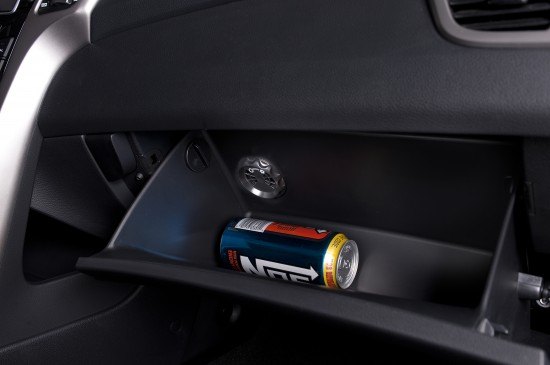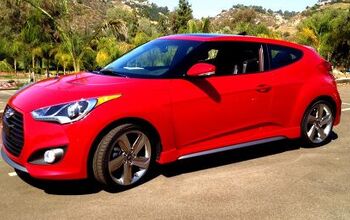Hyundai Generation Why Intramural League, First Place: 2013 Elantra GT
I may occassionally mock the enthusiast infatuation with wagons and hatchbacks, it’s only because they’re not such a big deal to me. Two-box compact and midsize cars (not crossovers or SUVs) are everywhere in my locale, to the point where they go unnoticed. But this is one worth getting excited about.
The Elantra Sedan and Coupe are nice vehicles, but driving one is like listening to Tyler Cowen talk about sex.Driving the Elantra GT elicits the same kind of titilation that women must feel when reading Fifty Shades of Grey. Not that I’d know…
The basic guts of the Elantra GT are shared with its two siblings, including the solid axle rear suspension, but the whole package works so much more proficiently in the GT than the other two cars – like how Khloe and Kim Kardashian come from the same lineage despite their wildly different physiques. While the other two cars resist being pushed hard (and don’t really prod the driver to do so), the Elantra GT is as comfortable motoring down the freeway as it is being grabbed by the scruff of its neck.
Hyundai had us drive the Elantra GT up and down a 5000 foot mountain pass, which did a good job of exposing both the highlights and the flaws that live within the car. The biggest impediment to going fast is the strange gap between second and third gear, no doubt a concession towards fuel economy. Running up and down the mountain at a spirited pace meant the car was often close to the rev limited in second. An upshift to third would bring the engine way out of the powerband, sapping whatever precious momentum we could extract out of the Elantra GT and its 148 horsepower 4-banger.
If you’re willing to keep it in second and let the revs fly, the Elantra GT is immensely rewarding. The chassis is responsive in a way that the Veloster and Elantra Coupe could only dream of. The brakes remained firm fade free during the whole route and the chassis inspires a ton of confidence, allowing you to push the car harder than the other two Hyundais driven that week. The steering, long a sore spot for the Koreans, is much crisper than any front-drive Hyundai vehicle in recent memory.
There was a lot of hoopla over the Driver Selectable Steering Mode, a steering wheel mounted button that lets you adjust the weight and resistance of the electric power steering. Many of my program participants insisted that the Sport mode (which did feel great) was the only way to go. There is a noticeable difference in weight between Comfort, Normal and Sport, but feedback remains the same no matter what. It’s ultimately a gimmick, though one that makes the driving experience better. It still can’t quite match the Mazda3 in sheer driving pleasure; the steering is just a little bit duller, the chassis slightly less enthusiastic (even though the Hyundai is 150 lbs lighter). But there are other benefits that make the Elantra GT a serious contender.
The Elantra GT is an elegant, mature looking vehicle without being dowdy. The Mazda3 looks absolutely heinous. Despite its many charms, the Mazda’s looks are enough to dissuade me from owning. The interior of the Elantra GT is also a much more pleasant place to be, with higher quality materials and a much more sophisticated design, which also manages to avoid being overly complex. The rear seats fold completely flat like a minivan, and the back seat is more spacious than one would expect. Up and down the mountain pass, with elevations reaching 5000 feet, the Elantra GT could handle whatever was dished out. Mid-corner bumps were absorbed gently without upsetting the car, and the brakes felt consistently strong despite substantial use. It was genuinely a joy to drive, despite being saddled with a gearbox that doesn’t flatter the engine’s modest output. The chassis is the real star of the show here, giving the driver lots of feedback, a high threshold for mistakes and the feeling that you’re going much faster than you really are.
Our tester was the $21, 145 Elantra GT equipped with the Style Package., The extra $2,750 nets you a large panoramic roof, leather seats, a power driver’s seat, 17-inch wheels and interestingly, stiffer rear springs. There were only a couple of base model Elantra GTs available at the event, so it was impossible to tell how much of an effect the Style Package has on handling.
Although the Elantra GT was sampled before the Veloster Turbo, not even the extra power and the supposedly sporty nature of the boosted hatch was enough to sway the decision.
It would be foolish to think that the Elantra GT will turn the tide on hatchback sales in the United States, but that doesn’t mean that Hyundai’s offering is any less competitive than the Focus, Mazda3 or even the Volkswagen Golf – which the Czech-built Elantra GT is arguably closest to in terms of overall character.
The Elantra GT wins not just on performance, but by offering an affordable yet mature looking proposition that works anywhere, whether it’s a golf game with someone important, a first date or hauling mountain bikes or skis. There are no extra options, engines or equipment packages needed to extract maximum fuel economy, and even though it’s a great value, you never feel like you’ve compromised on your vehicle due to your budget restrictions. The sedan and coupe versions should be this good.
N.B. our tester was black and the photos came out quite poorly. Hence the use of press photos.
More by Derek Kreindler
Latest Car Reviews
Read moreLatest Product Reviews
Read moreRecent Comments
- Bkojote Allright, actual person who knows trucks here, the article gets it a bit wrong.First off, the Maverick is not at all comparable to a Tacoma just because they're both Hybrids. Or lemme be blunt, the butch-est non-hybrid Maverick Tremor is suitable for 2/10 difficulty trails, a Trailhunter is for about 5/10 or maybe 6/10, just about the upper end of any stock vehicle you're buying from the factory. Aside from a Sasquatch Bronco or Rubicon Jeep Wrangler you're looking at something you're towing back if you want more capability (or perhaps something you /wish/ you were towing back.)Now, where the real world difference should play out is on the trail, where a lot of low speed crawling usually saps efficiency, especially when loaded to the gills. Real world MPG from a 4Runner is about 12-13mpg, So if this loaded-with-overlander-catalog Trailhunter is still pulling in the 20's - or even 18-19, that's a massive improvement.
- Lou_BC "That’s expensive for a midsize pickup" All of the "offroad" midsize trucks fall in that 65k USD range. The ZR2 is probably the cheapest ( without Bison option).
- Lou_BC There are a few in my town. They come out on sunny days. I'd rather spend $29k on a square body Chevy
- Lou_BC I had a 2010 Ford F150 and 2010 Toyota Sienna. The F150 went through 3 sets of brakes and Sienna 2 sets. Similar mileage and 10 year span.4 sets tires on F150. Truck needed a set of rear shocks and front axle seals. The solenoid in the T-case was replaced under warranty. I replaced a "blend door motor" on heater. Sienna needed a water pump and heater blower both on warranty. One TSB then recall on spare tire cable. Has a limp mode due to an engine sensor failure. At 11 years old I had to replace clutch pack in rear diff F150. My ZR2 diesel at 55,000 km. Needs new tires. Duratrac's worn and chewed up. Needed front end alignment (1st time ever on any truck I've owned).Rear brakes worn out. Left pads were to metal. Chevy rear brakes don't like offroad. Weird "inside out" dents in a few spots rear fenders. Typically GM can't really build an offroad truck issue. They won't warranty. Has fender-well liners. Tore off one rear shock protector. Was cheaper to order from GM warehouse through parts supplier than through Chevy dealer. Lots of squeaks and rattles. Infotainment has crashed a few times. Seat heater modual was on recall. One of those post sale retrofit.Local dealer is horrific. If my son can't service or repair it, I'll drive 120 km to the next town. 1st and last Chevy. Love the drivetrain and suspension. Fit and finish mediocre. Dealer sucks.
- MaintenanceCosts You expect everything on Amazon and eBay to be fake, but it's a shame to see fake stuff on Summit Racing. Glad they pulled it.














































Comments
Join the conversation
We've had ours (GT, SE, Tech, Auto) for about a week now (in Canada). Wife's car to replace a 2010 Civic. Drove all the current crop of equivalents including Focus, Honda Fit & Civic, Kia Soul, etc. The GT & Focus were heads above the rest. Aside from the fact that the GT was the only car that grabbed her, the Hyundai GT is at least $5k less than the Focus and had more content. She is v. happy so far.
I test drove an Elantra GT a couple of days ago and liked the car. However, the back seats most definitely DO NOT fold flat.